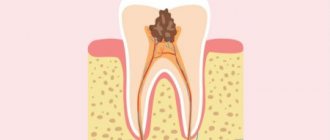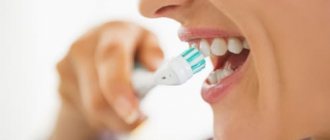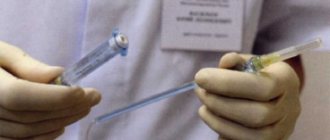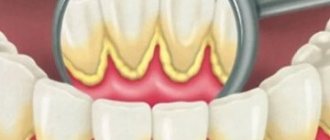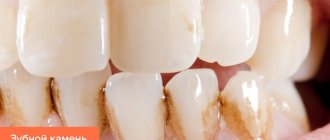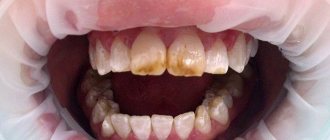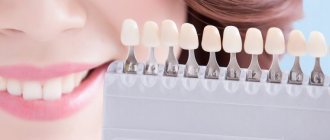Features of dental plaque in humans
Dental plaque is a kind of film invisible to the naked eye, consisting of living and dead microorganisms and bacteria.
Tartar is already a fairly hardened plaque that has a stronger and denser texture. It cannot be removed with a regular brush and paste.
Both plaque and stone settle on the surface of the teeth, gums, and in the space between the crowns, causing many pathologies. The accumulation of living and dead microorganisms can cause the development of caries, as well as gum diseases (periodontal disease, periodontitis). In addition, deposits spoil aesthetics - teeth become several shades darker and lose their shine. Professional dental cleaning of teeth and gums is necessary, even if the patient brushes his teeth several times daily. Here is the “gold standard” of affordable hygiene and mandatory dental care for teeth and gums.
What are the benefits of a therapeutic and cosmetic session?
The correction procedure has a multifaceted beneficial effect:
- Under the influence of an ultrasonic wave, hard foreign deposits are broken down over the entire surface, including the space under the gums. This result is not available using similar methods.
- Along with the cleansing effect, the enamel whitens, which acquires a natural shade - softer and more natural than after other corresponding procedures.
- After cleaning with the device, the doctor will be able to quickly identify pathologies of the tissues of the interdental space and gums.
- The procedure is painless and much faster than other methods.
- Cleaning helps during periodontal treatment and fillings. It is often recommended to remove deposits before prosthetics.
These are only the main results that can be achieved after completing the course of treatment. The beneficial qualities of the procedure are not limited to this.
Why does plaque settle on the teeth and then tartar form?
- due to the fast and not entirely thorough daily brushing of teeth - normal brushing should last at least 3 minutes;
- due to incorrect selection of toothbrush or toothpaste - for example, too soft bristles;
- when the patient does not clean the gums enough and does not clean the tongue (a large amount of bacteria also accumulates on the tongue);
- if the patient eats “simple carbohydrates”, carbonated drinks, foods with a high content of dyes;
- when the patient smokes and drinks alcohol;
- with an unbalanced diet;
- with increased salivation;
- if the patient suffers from diseases in which a large volume of pathogenic bacteria accumulates in the oral cavity;
- when eating viscous foods, etc.
Note!
The formation of tartar is a natural process that cannot be avoided, even by observing strict rules of personal oral hygiene. It is very important to monitor this by cleaning at least twice a year (or more often, as directed by your doctor).
How harmful can a service be?
A procedure approved by the medical community cannot be harmful by definition.
However, the method of ultrasonic cleaning of enamel requires a careful assessment of the condition of the teeth before starting treatment.
If the doctor misses the presence of contraindications or violates the order of work, the use of the device may harm the client’s health:
- cause damage to the enamel when it is weakened;
- injure the gums and cause bleeding.
More serious damage can be caused to the patient's body if he does not notify the dentist about existing contraindications.
Attention! Persons with pacemakers should be especially vigilant. Ultrasonic vibrations can damage the device that helps the heart function.
It is clear that the consequences of such treatment are not just harmful, but pose a mortal danger.
Features of professional cleaning from plaque and tartar
The work is performed by a dental hygienist, who, using special tools and solutions, removes all deposits from the surface, in the space between the crowns, and also from under the gums.
It is important!
If the patient has overly sensitive enamel, professional cleaning should be carried out no more often than once every twelve months.
After a complex of cleaning, the enamel becomes several shades lighter (do not confuse the procedure with whitening, these are still different things), the surface becomes smoother, shine appears, the general condition of the gums noticeably improves, and most importantly, the patient has a feeling of cleanliness of the oral cavity after a complex hygiene.
The professionalism of a dentist is not only to clean teeth and gums from hard stone, but also not to touch the deep layers of enamel, not to cause chips, cracks and loss of filling material.
When should teeth be cleaned to remove hard tartar?
- when your gums bleed;
- when the enamel acquires a rough texture;
- if the patient feels the presence of sharp edges of deposits (especially on the lower units);
- if the enamel becomes dull and acquires a grayish or yellowish color;
- with a “smoker’s plaque”, and this is accompanied by an unpleasant odor from the patient’s mouth;
- as mandatory hygiene before orthodontic treatment;
- after wearing braces;
- at the preparatory stage before the installation of veneers, before future artistic restoration;
- as a mandatory prevention of diseases of teeth and gums - at least once every six months.
When is it not recommended to brush your teeth?
This method of hygiene should be abandoned during pregnancy and breastfeeding, as well as in case of kidney disease and tuberculosis. The procedure should be carried out extremely carefully (or not at all) in cases of depleted and very thin tooth enamel, extensive caries lesions, viral diseases, immune pathologies, as well as in cases of diseases in the acute stage (for example, bronchitis, tonsillitis, etc.). Allergy to medications is also considered a contraindication for cleaning (for example, when performing Air Flow cleaning).
Existing contraindications
Contraindications to the treatment of deposits are not as extensive as one might think. Treatment is not carried out only in cases where the patient is in an exacerbation of any chronic disease or advanced oncology has been identified. Also, treatment is not carried out in the acute phase of the inflammatory process, during the period of active colds.
Consultation and diagnostics
Making a treatment plan
Treatment procedure
Preventive examination
Types of professional teeth cleaning: Air Flow, ultrasonic, laser, etc.
- Ultrasonic teeth cleaning is one of the most popular methods of removing tartar and plaque from under the gums, as well as from the teeth themselves and in the space between the crowns. To carry out the procedure, a dental apparatus with a scaler is used, which delivers ultrasound waves, breaking hard plaque into microparticles. Remains of bacteria are washed off with water. The equipment copes with even the largest and oldest deposits, subgingival calculus, as well as the so-called “invisible” supragingival deposits.
Average duration – should be carried out up to 45 minutes.The need for anesthesia is not always necessary. In some cases, an anesthetic gel is applied to the patient's gums.
The level of discomfort during the procedure is minimal.
- Laser teeth cleaning – the procedure is carried out using a laser device. A fluoride-containing gel is applied to the teeth and a laser beam is applied, which lasts for about 15 minutes. Particles of removed plaque and stone are removed with a stream of water. The laser beam eliminates hard deposits, as well as soft plaque, the so-called “cigarette plaque”, and “complex” subgingival calculus. A gentle and painless method that allows you to achieve perfect sterility. The laser also helps strengthen gums. After the procedure, the doctor may suggest polishing the teeth, due to which the effect is achieved as if after whitening.
Average duration – should be carried out up to 30 minutes.Anesthesia is not necessary.
There is no discomfort during the procedure, it is performed silently, the patient can feel a pleasant warmth.
- Air Flow is a professional procedure that involves treating teeth and gums with abrasives and air. The actions are combined with polishing and improving the tone of the enamel (the shade changes by a couple or three tones). The Air Flow procedure can be either separate or combined with ultrasonic teeth cleaning. The Air Flow procedure is based on the operation of a special machine that supplies a strong stream of water with abrasive microparticles. As a result, it is possible to wash away plaque from the teeth themselves, as well as from under the gums, in the difficult space between the crowns. The water jet works gently and prevents overheating of tooth enamel. At the same time, a high-quality gum massage is performed, which has a beneficial effect on blood circulation and the health of the gum tissue.
The average duration of dental treatment is about 40 minutes.There is no need for anesthesia when performing Air Flow, since the procedure does not cause pain.
Discomfort – with Air Flow there is no discomfort; a noticeable result is visible immediately after cleaning by the dentist. The powder contains aromatic particles that freshen breath.
- Chemical teeth cleaning is a highly effective procedure for removing plaque and tartar using chemical reagents that dissolve formations. The method is used when, for example, ultrasonic cleaning and Air Flow cannot cope with deposits. A chemical mixture with the addition of hydrogen peroxide is applied to the old stone and washed off after a few seconds.
Average duration – should be carried out for 25 minutes.The need for anesthesia is not always necessary; in general, with a professional approach, the procedure is painless.
- Manual cleaning of plaque is a procedure without the use of devices. The method is implemented using a special tool: hooks with sharp tips, with which the dentist “catches” the subgingival stone and removes it from hard-to-reach places.
Average duration – should be carried out up to 30 minutes.Anesthesia is necessary; the gums are covered with an anesthetic gel.
There is no discomfort with the right approach; a professional dentist performs everything carefully, without injuring the teeth and gums.
Recommendations after teeth cleaning to maintain and prolong the effect of the procedure
- Do not brush your teeth for the first 24 hours, but you can use dental floss and rinse your mouth for a minute with plain water;
- remove foods and drinks with coloring pigments from your diet;
- in the future, use a medium-hard toothbrush (it is advisable to choose it in tandem with your dentist);
- change your toothbrush about once a quarter;
- choose a paste taking into account the condition of your enamel and the characteristics of your teeth and gums (it is also better to do this in tandem with a doctor);
- Follow the rules of good daily oral hygiene.
Removal at home
It is impossible to remove hardened tartar at home. The only thing you can do is try to remove soft dental plaque. To do this, use special rotating toothbrushes and abrasive toothpastes. You can use such compositions no more than twice a week so as not to damage the enamel.
The use of folk remedies gives a dubious effect, but, if desired, you can try and see for yourself.
- Radish and lemon juice. Grate the radish, add natural lemon juice. Wet the brush and rub your teeth. (The main component of this “elixir” is acids that destroy enamel).
- Eggplant ash. The vegetable should be burned over an open fire, and the most problematic areas should be rubbed with ashes every day. The expected result can be observed after a week and a half.
- Horsetail decoction (for 200 grams of water - 30 grams of dry herb). Boil for half an hour. Rinse your mouth morning and evening with 1/3 cup.
Important. Among the “folk” recipes found online, there is an infusion of celandine, the use of which poses a health hazard.
How much does a good scale cleaning cost?
Today, effective removal of tartar in Moscow costs around 3,500 rubles. This amount includes:
- patient consultation with a dental hygienist;
- anesthesia (if necessary);
- use of a mouth dilator;
- removal of hardened deposits - in the sub- and supragingival zones;
- grinding of all teeth;
- recommendations for home oral hygiene and prevention.
If you go by the price list of the 32 Dent clinic, the cost of hygiene using the gentle and comfortable Air Flow method will be approximately 4900 rubles. This amount includes:
- elimination of pigmented plaque using the Air Flow device;
- grinding and polishing with dental paste;
- selection of individual products for oral hygiene and prevention tips.
All the measures that we have described relate to the powerful prevention of caries and other pathologies of the oral cavity. It is much easier, more comfortable and more profitable to perform such inexpensive and relatively simple prevention than to spend a lot of time, effort and finances on treatment in the future.
Sources:
- Personal experience as a periodontist;
- Borovsky E.V., Ivanov V.S., Maksimovsky Yu.M., Maksimovskaya L.N. Therapeutic dentistry. Textbook / - M.: Medicine, 2001;
- Grudyanov A.I., Ovchinikova V.V. Prevention of inflammatory periodontal diseases. - M., 2007;
- Danilevsky N.F., Magid E.A., Mukhin N.A., Milikevich V.Yu. Periodontal diseases. - M.: Medicine, 1993;
- Kuryakina N.V., Savelyeva N.A. Dental prevention. — M.: Med. Book N. Novgorod: Publishing house NGMA, 2003;
- Ulitovsky S.B. Oral hygiene in periodontology. - M.: Medical Book, 2006;
- Ulitovsky S.B. Encyclopedia of preventive dentistry. - St. Petersburg, 2004;
- Ed. Maksimovsky Yu.M. - Therapeutic dentistry. - M.: Medicine, 2002.
Service cost
Offers for dental correction with ultrasound are provided in private dental clinics. It is not included in the mandatory list of free procedures.
The average cost of one course varies between 1500-3000 rubles. The difference in price is due to the marketing policy of dentistry and additional actions, for example, the need for anesthesia.
In addition to complete cleaning, you can order cleaning of one or more teeth. In this case, you will have to pay from 100 to 150 rubles to clean each one.

